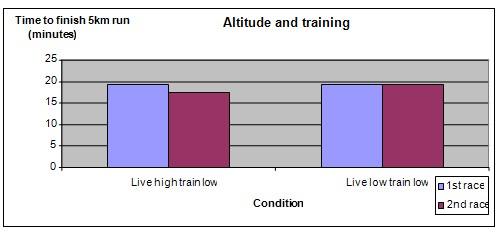| Complexity level: | 8 |
| Project cost ($): | 20000 |
| Time required: | 1 day to prepare, 1 month to conduct the science project experiment |
| Material availability: | Easily found |
| Safety concerns: | Basic safety requirements |
Hypothesis
Living at high altitudes and training at lower altitudes can help to improve an athlete’s performance.
Overview
Live high train low
For many years, it has been believed that endurance athletes can perform better by living and exercising at high altitudes. However, recently, doctors have questioned the effectiveness of this approach and propose that living at high altitudes and training at lower altitudes will better benefit the athletes. Some studies claim that by doing this, the performance of athletes may be improved by 1 to 2 percent.
Living at high altitudes where the oxygen levels are lower will cause the body to produce more red blood cells over time to compensate for the lack of oxygen in the body. However, athletes will not be able to optimize their training in high altitudes due to the lower oxygen levels. Their performance actually deteriorates and they may even suffer from muscle loss. But when athletes train at low altitudes, their higher concentrations of red blood cells enhances their strength, speed, endurance as well as recovery.
The live high train low concept capitalizes on the benefits of high altitude training and avoids the adverse effects of low oxygen levels during training. Athletes in various sports are believed to benefit from this concept of live high train low.
Scientific Terms
Materials
The materials required for this science fair project:
- 20 long-distance runners between ages 16 to 20 years (you might be able to enlist the help of track teams from your school or a nearby college)
- A 5 km cross country path
- A stopwatch
- A high altitude hill top residence rented for 1 month
- A low altitude sea level residence rented for 1 month (the costs of this experiment are high due to the need to provide the athletes with accommodation)
- daily transportation for the athletes
- an athletics coach
- writing materials
Procedure
1. For this science fair project, the independent variable is where the athletes reside during the experiment, i.e. at high altitude or at sea level. The dependent variable is the time taken by the runners to complete the 5 km run. The time taken to complete the 5 km run is measured with a stopwatch. The constants (control variables) are the age of the participants, weather conditions and the distance of the cross country route.
2. On the 1st day of experiment, the 20 athletes are made to run the 5 km cross country route. The time taken by each of the athlete to complete the 5 km run is noted. The athletes are then divided into 2 groups of 10 persons each so that the average time of the runners in each group is almost the same. The average time is calculated by totaling the time taken by all the runners in the group and dividing by 10.
3. For the next 30 days, the 1st group of 10 athletes will reside at the hill top residence. They will train at sea level everyday.
4. The 2nd group of 10 athletes will reside at the sea level residence. They will also train at sea level everyday. The method and intensity of the training for the 1st and 2nd group of athletes will be the same.
5. After the 30 days, the 2nd race is held and the runners are made to run the same 5 km cross country route. The time each of the athletes takes to complete the 5 km run is recorded. The new average time taken for each of the 2 groups is calculated and is recorded in the table given below.

Results
The results show that the athletes who lived at the high altitude residence but trained at low altitude were able to better their performance significantly, over the period of 1 month, whilst the athletes who both lived and trained at low altitude managed to improve their performance only marginally.
| Group | Pre-condition | Time taken to complete the 5 km run (minutes) | % change | |
| 1st race | 2nd race | |||
| 1st | Live high train low | 19.27 | 17.32 | -10.1% (faster) |
| 2nd | Live low train low | 19.3 | 19.12 | -0.1% (faster) |
Use the below graph to plot the results of above observation.

Conclusion
The hypothesis that living at high altitudes and training at lower altitudes can help improve an athlete’s performance is proven to be true.
Also consider
This science fair project can also be done on other sports like swimming, cycling and triathlons.
This experiment can also be repeated using different levels of altitudes and different age groups of athletes.
As an alternative (and cheaper) way of conducting this experiment, consider replicating high altitude living conditions using an Altitude Tent (such as the Colorado Altitude Training system).
References
Live high, train low and move faster - http://www.nytimes.com/1998/10/27/science/live-high-train-low-and-move-faster.html?pagewanted=1
Altitude training - http://www.altitude.org/altitude_training.php

